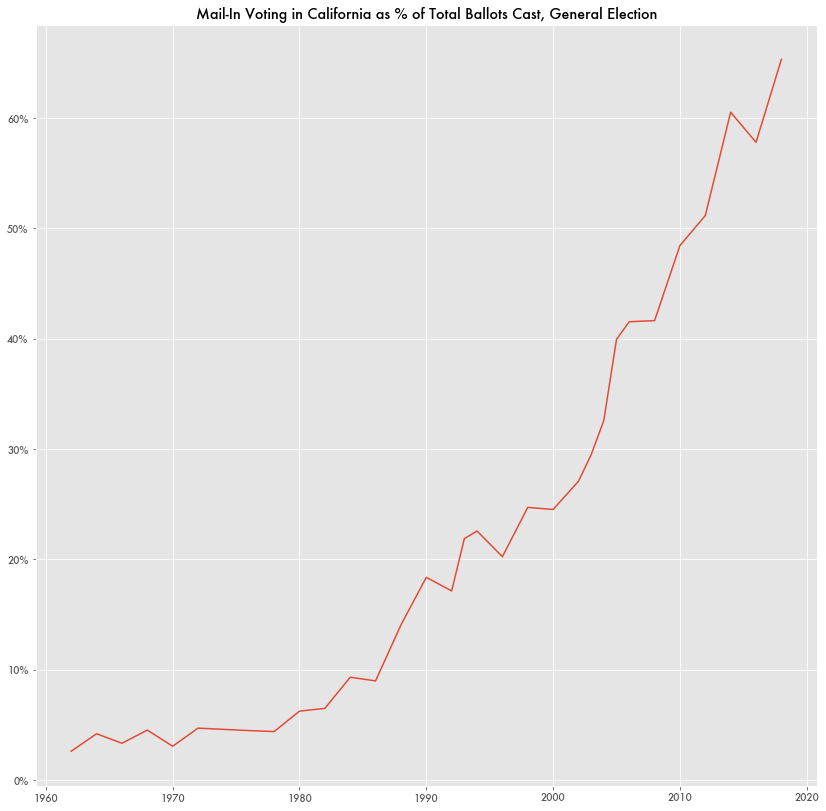Large Growth in Voting By Mail Preceded 2020 Election
The 2020 election is set to break numerous records in the number of ballots cast in a U.S. election and the number of those ballots cast by mail. As a result of the pandemic restrictions, more states allowed voting by mail and early voting to avoid large, in-person voting.
As of November 12th, an estimated 65.5 million mail-in votes were counted, or 73 percent of the total 2016 vote, according to the New York Times. That number far surpasses the 12.1 percent absentee vote of 2004.
Absentee voting—specifically requesting a mail-in ballot because a voter will be absent on election day—has been on a fast incline since 2004 without the pandemic, according to a 2016 report by the U.S. Election Assistance Commission (EAC). In 2016, the absentee rate was over 23 percent—over double what it was 12 years prior.
In California, the prevalence of mail-in voting has been on an exponential path since the 1990s. The mail-in voting rate doubled from 32.61 in 2004 to 65.31 percent in 2018.
Besides absentee voting, numerous states like Oregon and Washington have enabled mail-in voting by default, and that as a category—non-absentee mail-in voting—has gone from non-existent 20 years ago to over 7 percent of total votes in 2016.
Absentee Voting and Fraud Accusations
Absentee votes have become a focal point of ongoing accusations of the Trump administration of voter fraud, and the president has accused the election of including numerous fraudulent votes. While registration fraud and error can be commonplace, actual voter fraud is rare. But of the known voter fraud incidents, absentee voter fraud accounts for the majority.
An ongoing accusation is that Chicago Mayor Richard Daley helped win the state of Illinois for John F. Kennedy in 1960 by submitting absentee ballots on behalf of deceased voters and nursing home residents in Cook County. The Republican Party repeatedly attempted to prove that the election was fraudulent in court but was unsuccessful.
Different states have different requirements, but most lean on signature verification for verifying the identity of absentee ballots. Signature verification is the largest reason for rejecting mail-in ballots, but verifying a signature is a fraught process. In a lawsuit brought by the ACLU against the state of New Hampshire, the organization called the process “fundamentally flawed” as it is handled by moderators with no training in handwriting analysis “without any review or appeal.”
A few states like Alabama require a photocopy of the voter’s identification include with the ballot. In the run-up to the 2020 elections, numerous lawsuits were filed against various states, including Alabama and Missouri, by groups like the National Association for the Advancement of Colored People (NAACP) and the American Civil Liberties Union (ACLU) over restrictions on absentee voting, including Alabama's requirements on photocopying voter IDs or notarization.
Absentee votes were also at the heart of the 2000 election dispute between George Bush and Al Gore. Gore was ahead in the vote by 202 votes in Florida, a critical state that would determine the presidency, but an additional 2,411 absentee ballots would come in and turn the tide for Bush, some of them from overseas military personnel. Some of those votes might be considered invalid because of late postmarks, missing signatures, or invalid registrations. Republicans lobbied to include the late votes while Democrats pushed to scrutinize and reject as many as they could.
A New York Times story afterwards would point out that 680 votes might be considered invalid, enough to potentially sway the election, but there was no way to tell whether those invalid votes would have gone for Bush or Gore.
In the wake of the 2000 election fracas, there would be a flood of reports by independent groups and congressional testimony supporting easing the rules for absentee voting because of the issues surrounding overseas military votes: Caltech/MIT Voting Technology Project, The Constitution Project, the National Association of Secretaries of State (NASS), National Association of State Election Directors, National Commission on Election Standards & Reform, National Conference of State Legislatures (NCSL), and the National Task Force on Election Reform.
While most of the encouragement for expanding absentee voting was to encourage military votes under the Uniformed and Overseas Citizens Absentee Voting Act (UOCAVA), but UOCAVA and overseas civilian voting remains a small sliver of the by-mail voting population. In 2016, those two groups accounted for less than a million votes in total.




